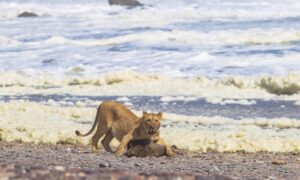There is an alien in the desert. OK, that’s a slight exaggeration, but deep in the Namib Desert, there is a plant that is an anomaly. In Afrikaans, it is called the plant with “two leaves that cannot die.” Some indigenous groups call it the “onion of the desert.” To botanists, it is a living fossil that can grow continuously for 2,000 years.
The ugliest plant
The unique plant was first described by Western science in 1859 when Austrian botanist Friedrich Welwitschia visited Angola. It only grows in Namibia and Angola, in an area that stretches from the Nicolau River to the Kuiseb River and in the northern and central regions of the Namib Desert.
Welwitschia described himself as basking in awe and fear when confronted by the strange plant with extremely long, broad leaves. News of the plant spread and prompted artist Thomas Baines and botanist Thomas Dalton Hooker to research the plant. Hooker, a director of Britain’s Royal Botanical Gardens, referred to the welwitschia as both “wonderful” and the “ugliest” plant he had ever seen.

Welwitschia leaves are two leaves split into thinner sections. Photo: Anton_Ivanov/Shutterstock
The welwitschia can be either male or female. The seeds develop in something called a “pollen cone” and when the seeds emerge and are fertilized by birds or insects, they eventually become two large, flat leaves. The two leaves, attached to the base of the plant, then split into multiple, thinner leaves.
At around the 18-month mark, the leaves’ edges start to dry up. The leaves are approximately one and a half centimeters thick and can withstand the desert’s most powerful winds.
Massive size
The growth rate is an unchanging 15cm per year and the largest welwitschia ever recorded measured 1.5m tall and almost 3m in diameter. The longest unbroken leaf measured 6m.
The large leaves help keep the base of the plant shady, keeping the soil cool and retaining a small but consistent water supply for its survival. The area that the leaves protect is called the basal meristem.
The shade also draws in many small animals who wish to seek refuge. Namibia does not get much rainfall, only a maximum of 100mm annually, so this plant is something of a miracle worker.
Writer Gillian Cooper Driver refers to this plant as a paradox as “its leaves appear not to have special water storage tissues.” But even though mist droplets and groundwater may not seem like much, a little can go a long way. Its water retention abilities work in conjunction with its ability to cool itself. It absorbs carbon dioxide by opening its stomata during the day and then closing it at night to keep the leaves cool.

The inside of the welwitschia, up close. Photo: PURIPAT PENPUN/Shutterstock
Collects water via morning fog
The welwitschia is a valuable food and water source in the scorching desert. Animals such as zebras, rhinos, springboks, and oryxes need it to sustain themselves in the harsh environment. Indigenous people in the region, the Damara and Hereo, use it as a food source, preferring to eat the seeds.
Scientists speculate that the plant collects water via morning fog from the Atlantic Ocean and from groundwater. This ability to absorb water from its surroundings contributes to its longevity, helping it live for over 1,000 years. Essentially, this plant does not die, the leaves continue to grow and fan out onto the desert floor.
The oldest welwitschia on record is 2,000 years old, during its lifetime the Roman Empire fell, the Black Plague ravaged Europe, and humans left Earth. Determining the age of the welwitschia is usually done by carbon-14 testing.
The welwitschia is on Namibia’s coat of arms. It lies at the base of a dune flanked by two oryxes. It symbolizes the fortitude, resilience, and tenacity of the Namibian people.






